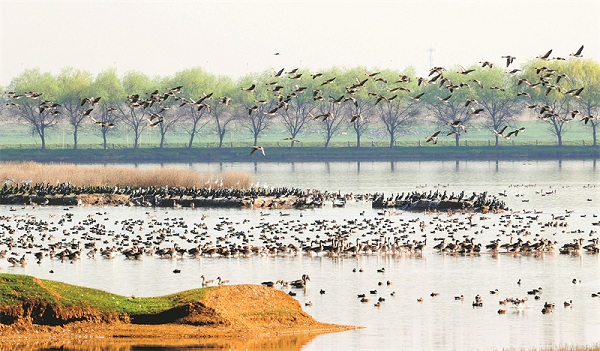COP14 calls for joint efforts on wetland protection

Migratory birds from Northeast China and Siberia gather at the Fuhe Wetland Park in Wuhan last winter. [Photo/China News Service]
The Wuhan Declaration — a major achievement of the ongoing 14th Meeting of the Conference of the Contracting Parties to the Ramsar Convention on Wetlands — which was released on Sunday, is committed to mobilizing more resources to take more effective actions for wetlands protection by 2030.
The meeting began on Nov 5 and continues through Nov 13 in Wuhan, Hubei province and Geneva, Switzerland.
The declaration said that international technical institutes and committees should enhance cooperation in knowledge sharing among wetland conservationists worldwide.
Officials said they expect more cooperation in technology and science between the parties to protect and restore wetlands.
Musonda Mumba, secretary-general of the convention, said at a news conference on Sunday that the declaration emphasizes the protection of wetlands and the rational use of resources to address climate change, conservation of biodiversity and reduction of disaster risks.
She said that she looked forward to the parties working closely in the technical and scientific sector including data collection, tracking and monitoring to better implement the convention.
Bao Daming, deputy head of the National Forestry and Grassland Administration's wetland management department, said at the conference that the main goal of international exchanges lies in the introduction of technology.
"What we want is to use the most advanced technology to restore and protect wetlands. Meanwhile, we would like to provide developing countries with scientific and technological support as much as we can," he said.
Bao said the scientific research on wetlands protection from now until 2030 has been drafted.
"For example, we will crack the nut of studying the relationship between wetlands and climate change and the evolution law study of wetland ecosystems, which would be huge research," he said.
Key technologies of wetland ecological restoration are also needed for the conservation work.
"For example, we need to figure out ways to tackle the destruction of mangroves," he said.
In addition to technical cooperation, the declaration encourages prioritizing conservation and management of vulnerable ecosystems including peat land, coral reefs and sea grass beds, mangroves, highland wetlands and groundwater systems.
The declaration also calls for the promotion of legislation and enforcement for the protection, restoration, management and sustainable use of wetlands.
Since the convention took effect in 1971, natural wetlands have declined by 35 percent globally, damaging ecosystems, despite constant efforts in wetlands conservation, the declaration said.
The signatories should recognize that wetland ecosystems, though vulnerable to climate change, can protect water resources, reduce erosion and withstand floods and storm surges, thereby maintaining biodiversity if they are managed in a sustainable way, it said.




